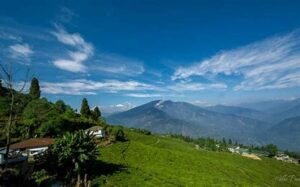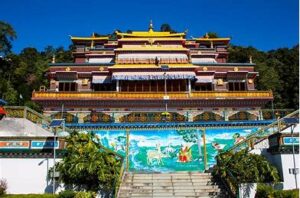Introduction
Perched on a quiet hilltop overlooking the vibrant city of Gangtok, Rumtek Monastery is not only the largest monastery in Sikkim but also one of the most significant Buddhist monastic institutions in India. As the principal seat of the Karma Kagyu lineage outside of Tibet, Rumtek stands as a symbol of spiritual continuity and resilience amidst historical and political upheaval. For centuries, it has welcomed monks, scholars, pilgrims, and tourists alike, all drawn to its grandeur, tranquility, and deep-rooted spiritual presence.
In this blog, we will explore the historical journey, architectural elegance, religious significance, festivals, and visitor experience of Rumtek Monastery — a place where the past and present coalesce in sacred harmony.
A Glimpse Into History
The original Rumtek Monastery was founded in the 16th century by Wangchuk Dorje, the 9th Karmapa Lama, one of the highest spiritual leaders in Tibetan Buddhism. At the time, the monastery was relatively modest, catering primarily to the local Buddhist population and functioning as a regional center of learning and meditation.
However, the geopolitical landscape changed dramatically in the mid-20th century. With the Chinese annexation of Tibet in the 1950s, the Tibetan diaspora fled across the Himalayas. Among them was Rangjung Rigpe Dorje, the 16th Karmapa, who sought a new home for the Karma Kagyu lineage. Sikkim, a Buddhist kingdom at the time and a long-time patron of Tibetan Buddhism, welcomed the exiled spiritual leader.
With the support of the Sikkimese royal family and Buddhist devotees worldwide, the new Rumtek Monastery was constructed in the 1960s, mirroring the design and spiritual blueprint of Tsurphu Monastery, the traditional seat of the Karmapas in Tibet. This reconstruction gave birth to the Rumtek Monastery we know today — a monumental structure symbolizing the revival and preservation of Tibetan Buddhism in exile.
Architectural Splendor of Rumtek
One of the most captivating aspects of Rumtek Monastery is its Tibetan architectural brilliance. The complex is built in the traditional gompa style, characterized by a symmetrical layout, vibrant murals, tiered roofs, ornate wooden carvings, and elaborate shrines.
The central building, known as the Dharma Chakra Centre, serves as the main prayer hall. It is adorned with:
- Beautiful frescoes depicting scenes from Buddhist scriptures.
- Sacred Thangka paintings, some of which are centuries old.
- A 10-foot golden statue of Buddha Shakyamuni, sitting serenely at the altar.
- The Golden Stupa, said to contain relics of the 16th Karmapa.
Surrounding the main temple are several other buildings, including:
- The Karma Shri Nalanda Institute for Higher Buddhist Studies, a monastic college offering advanced studies in Buddhist philosophy.
- The monks’ quarters and retreat center, where hundreds of monks live, study, and practice.
- A protective wall of 108 prayer wheels, which devotees spin while chanting mantras for merit and purification.
Everything about the structure — from its symmetry to its symbolism — is designed to reflect Buddhist cosmology, reinforcing the spiritual energy of the site.
The Heart of Karma Kagyu Lineage
Rumtek is more than just a monastery — it is the international headquarters of the Karma Kagyu lineage, one of the four major schools of Tibetan Buddhism. The lineage emphasizes the transmission of spiritual realization through meditation and direct master-student relationships.
The Karmapa, who heads the Karma Kagyu school, is considered the first reincarnate lama in Tibetan history — a tradition that dates back to the 12th century. The presence of the Karmapa’s seat in Rumtek makes the monastery immensely important not only to followers in Sikkim and India but across the Tibetan Buddhist world.
The monastery has also witnessed controversies over the recognition of the 17th Karmapa, with two claimants — Ogyen Trinley Dorje and Trinley Thaye Dorje — leading to political and spiritual tension. Despite these complexities, Rumtek remains a central symbol of the Karma Kagyu heritage.
Rituals, Prayers, and Daily Life
Life at Rumtek Monastery is defined by spiritual discipline, ritual precision, and communal living. The monks follow a strict daily schedule involving:
- Chanting of sutras and mantras in the early hours.
- Meditation and individual retreats for advanced practitioners.
- Teachings and scriptural debates as part of monastic training.
- Offering rituals (pujas) for the welfare of all sentient beings.
A particularly significant spiritual practice is the Mahakala Puja, a fierce protective ritual performed to dispel obstacles and negative energies.
In addition to religious practices, the monks are involved in community service, education, and the preservation of Tibetan art, music, and literature.
Festivals and Celebrations
Rumtek Monastery is famous for its vibrant and spiritually charged festivals, many of which draw devotees from across the Himalayas and beyond.
Kagyed Dance Festival
Held just before the Tibetan New Year, this masked dance festival involves elaborate performances symbolizing the triumph of good over evil. Monks don intricate costumes and masks representing various deities and spiritual beings, performing age-old ritual dances to the sound of cymbals and drums.
Losar – Tibetan New Year
During Losar, the monastery becomes a hub of activity with special prayers, fire offerings, and festivities that last several days. It is a time for both spiritual renewal and social celebration.
Karma Kagyu Monlam Chenmo
One of the most significant prayer festivals, the Karma Kagyu Monlam Chenmo gathers monks and lay practitioners for collective prayers, aspirations, and teachings for world peace and enlightenment.
These festivals not only provide spiritual merit but also preserve the rich cultural traditions of Tibetan Buddhism.
Tourism and Visitor Experience
Rumtek Monastery is open to visitors of all faiths and backgrounds, making it a major tourist attraction in Sikkim. The journey to Rumtek — about 24 km from Gangtok — winds through picturesque valleys and pine-covered hills. Upon arrival, visitors are greeted by fluttering prayer flags, panoramic mountain views, and the quiet grandeur of the monastery itself.
Some key aspects of the visitor experience include:
- Guided Tours: Available on request, giving insights into Buddhist rituals, history, and symbolism.
- Photography: While photography is allowed in certain areas, it’s restricted inside the main prayer hall.
- Meditation Spaces: Visitors are encouraged to sit quietly, meditate, or observe the monastic rituals.
- Souvenir Shops: Offering handicrafts, books, incense, and Tibetan artifacts.
Nearby attractions include the Nehr u Botanical Garden, Jawaharlal Nehru Institute of Mountaineering, and Lingdum Monastery, allowing tourists to make a full day of their visit.
Best Time to Visit: October to March, when the skies are clear, and the surrounding landscapes are breathtaking.
Educational and Cultural Importance
Rumtek Monastery plays a crucial role in the preservation of Himalayan culture, not just as a religious center but as an educational institution. The Karma Shri Nalanda Institute provides higher education in Buddhist philosophy, logic, debate, and meditation. Students from India, Nepal, Bhutan, and the West travel here to receive teachings from learned scholars and reincarnated masters.
Moreover, the monastery acts as a repository of Tibetan art and scriptures, many of which were rescued from Tibet and brought to India. The continuous recitation of sacred texts, the training of monks in ancient ritual dances, and the publication of Dharma books ensure that the intangible heritage of Tibetan Buddhism is not lost.
Challenges and Controversies
Despite its spiritual prominence, Rumtek Monastery has faced several challenges, especially surrounding the Karmapa controversy. Due to conflicting recognition of the 17th Karmapa, the monastery has remained under tight security, and the Karmapa’s seat at Rumtek remains unoccupied.
This dispute has led to divisions within the Karma Kagyu community and has affected the monastery’s internal administration. Nevertheless, the faithful continue to uphold the practices and lineage of the Karma Kagyu tradition, with hope for resolution and unity in the future.
Conclusion
Rumtek Monastery is more than just the largest monastery in Sikkim — it is a living embodiment of Tibetan Buddhist wisdom, resilience, and beauty. From its roots in the 16th century to its reconstruction in exile, it tells a story of spiritual survival against odds. Whether you’re a devout practitioner, a cultural historian, or a curious traveler, Rumtek offers something profound — an opportunity to experience stillness, heritage, and the spiritual heartbeat of the Himalayas.




